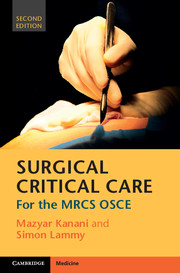1 - Airway
from Section 1 - Ward care (level 0–2)
Published online by Cambridge University Press: 05 July 2015
Summary
Assessment
Airway assessment
How is the airway assessed clinically?
Assessment is based on the principle of: Look, Listen and Feel.
Look: for the presence of accessory muscles of respiration (neck, shoulders, chest and abdomen) being used, presence of obvious foreign bodies in the airway, facial/airway injury and the ‘see-saw’ pattern of complete airway obstruction (NB. central cyanosis is a late sign)
Listen: for the presence of inspiratory stridor, as this indicates upper airways obstruction (laryngeal level and above). Also take note of grunting, gurgling (liquid or semi-solid foreign matter in the upper airways) and snoring sounds (indicating the pharynx is partially occluded by the tongue or palate). Expiratory wheeze suggests lower airways obstruction. Crowing indicates laryngeal spasm
Feel: for chest wall movements and airflow at the nose and mouth (for 10 seconds)
Note that in cases of trauma, the assessment has to be performed with cervical spine (C-spine) control.
What techniques of airway management do you know?
Broadly speaking there are simple and definitive airway management techniques that increase in complexity if previous measures fail
• Simple measures
▪ Basic airway manoeuvres: these include a head tilt, chin lift and jaw thrust, which open up the airway and permit the use of rigid suction devices (Yankauer sucker) to clear secretions and forceps (Magill) to remove solid debris
▪ Basic airway adjuncts: these include nasopharyngeal and oropharyngeal airways. If a patient tolerates an oropharyngeal, then it is prudent to request an anaesthetic review as the airway is at risk of imminent collapse
•Complex measures
▪ Endotracheal intubation: this requires anaesthetic expertise and can be achieved through the mouth (orotracheal) or the nose (nasotracheal) intubation
▪ Surgical airway: this requires a cut down through tissues in the neck and can be achieved in three ways (see Airway Adjuncts)
How are the head tilt, chin lift and jaw thrust manoeuvres performed?
- Type
- Chapter
- Information
- Surgical Critical CareFor the MRCS OSCE, pp. 3 - 20Publisher: Cambridge University PressPrint publication year: 2015

